How to Paint Anything in Your Home
Painting is a popular do-it-yourself home improvement project that more and more people
feel comfortable taking on themselves. Whether you are working on a small craft project or
large home improvement project, with the proper materials and techniques and
the right high-quality paint, you can paint almost anything with these helpful tips.
Choosing Your Paint
Water-based and latex paints are easier to work with and easier to apply than oil-based paint.
While oil-based paints are more durable than latex paints, they take longer to dry. Latex paints work
well for furniture, walls, and ceilings. Oil-based paints work nicely with projects like molding
or trim, because they need a more long-lasting, resilient paint.
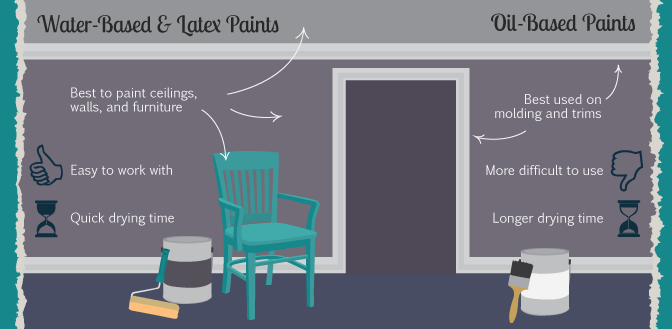
On some projects, you may consider using spray paint as well. Spray paint can be used on
several surfaces, including metal, wood, glass, and fabric, and now comes in a variety of
types including indoor, outdoor, and paint/primer mixes. When spray painting, be sure
to spray in a well-ventilated area to protect yourself from paint fumes.
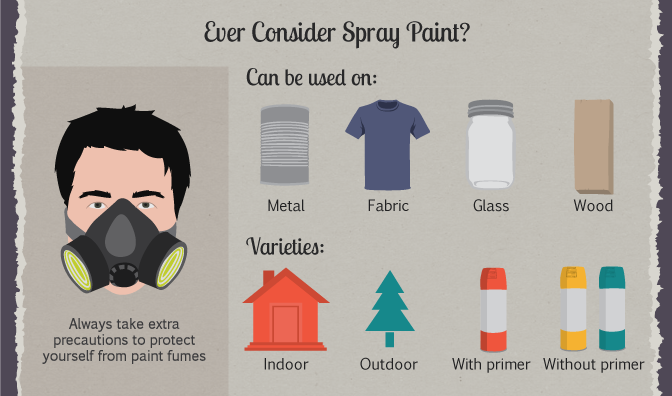
Metal
A rusted, worn, old piece like a metal gate will look brand new with a fresh paint job.
To prepare metal, use a stiff wire brush found in the paint section of a hardware store to
remove rust, old paint, and debris. Depending on its condition, you may need to sand the surface as well.
If this is the case, start with 60-grit sandpaper and work your way to a finer grit. Prime it – use
two coats of high-quality primer that prevents rust – and allow it to dry completely between coats.
Purchase high-gloss enamel paint made especially for rust protection. Both the primer and paint
are available in spray paint form.
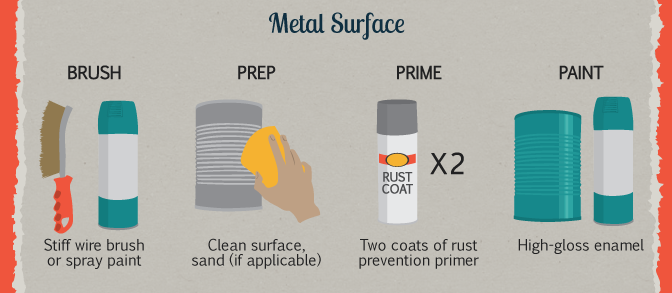
Wood
If you are working on furniture, remove all hardware, including pulls, knobs,
hinges, and screws. If you are using new hardware, be sure to patch any holes or
blemishes with wood filler. Wipe away dust and debris, and sand, starting with 80-grit
sandpaper and working your way to a finer grit. Use a hand block sander for small projects and
an electric sander for large furniture pieces. Remove any dirt with household cleaner and a clean
cloth. Apply two coats of stain-blocking primer, allowing it to dry between coats. You can opt to
use a roller brush or bristle brush, or even spray paint. Apply two coats of the paint in the
direction of the grain. If you are using spray paint, spray in a smooth motion in light coats.
To protect a surface like a dresser top or tabletop, apply two coats of polyurethane.
Laminate
Covering an old piece of laminate furniture with paint is a great way to bring it new life.
First, remove any hardware from your piece of furniture. Use fine-grit sandpaper, around 150-grit,
to sand the surface. It is important not to over-sand. Remove any dust and debris with a soft,
clean cloth. Apply two light coats of primer with a soft high-quality brush, allowing the primer
to dry for approximately one hour between coats. Paint the piece with latex paint,
using a roller or brush.
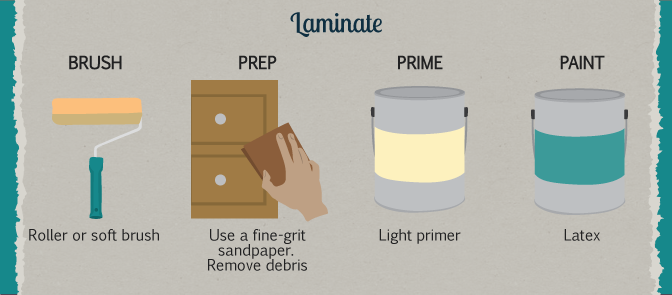
Brick
Painting brick can give a fresh new look to otherwise old or out-of-date surfaces.
Start by cleaning the surface with soapy water. If you are painting outdoor brick, you
can use high-pressure water. If the brick is extra grimy, use a wire brush and
Trisodium Phosphate, a heavy-duty cleaner that you can purchase at any hardware store,
to help loosen and remove any grime. After the brick is clean, allow it to dry.
Apply caulk to any areas with holes that need repair. Apply a high-quality acrylic
or latex masonry primer. You can also choose to use a stain-blocking primer to hide
any soot stains, if you are painting a fireplace. Use an interior or exterior latex
paint and, depending on your project, apply with a roller, brush, or paint sprayer.
Glass
Painting stemware, vases, and other decorative glass is a great way to add a personal touch.
Wash the glass with warm water and soap and dry it thoroughly. Next, clean the glass surface with
vinegar or rubbing alcohol and make sure it is completely dry. This will ensure there is no leftover
film or residue. An artist’s brush with synthetic or natural hair bristles works well for most
projects, although natural hair bristles leave a smoother finish than synthetic brushes.
Choose acrylic enamel paint or enamel paint for decorative glass projects.
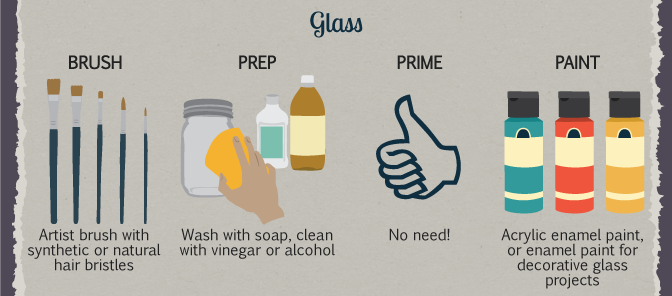
Ceramic
Transform everyday ceramics into creative works of art by painting them.
You may need to prepare some ceramic surfaces, like ceramic tiles, by sanding them to
improve adhesion. In those cases, use 150-grit sandpaper. Clean your surface with Trisodium
Phosphate and a soft cloth to remove grease and dirt. You may want to use a handheld vacuum
to remove debris first. You can use latex paint with a brush or use paint pens made for ceramic
panting. Allow the paint to dry and cure for several days – ideally up to two weeks. Some small
decorative pieces need to be baked at 300 degrees for 35 minutes.
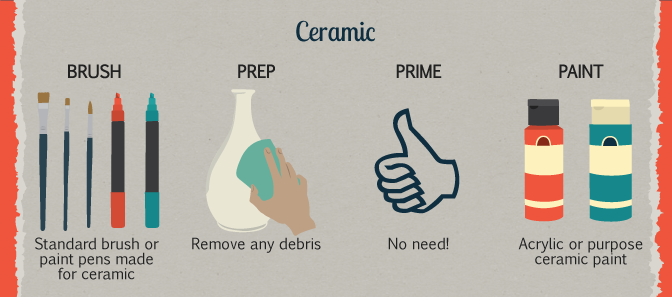
Fabric
In these days of Pinterest and other inspiring DIY resources, painting fabric is not
uncommon. It is a different way to achieve a stylish look for treasured pieces of furniture
without reupholstering, or embellishing a throw pillow without buying new. A flat acrylic or
latex fabric paint or fabric spray paint works well on several types of projects. You can use
a paint brush for small projects, and spray paint for large projects.
As a general rule, when buying paint it’s important to pick quality over price.
No matter the type of surface you are painting, remember to start with a clean and dry surface.
With the right paint, materials, and techniques you can tackle your next paint job like a pro.
Embed the article on your site

